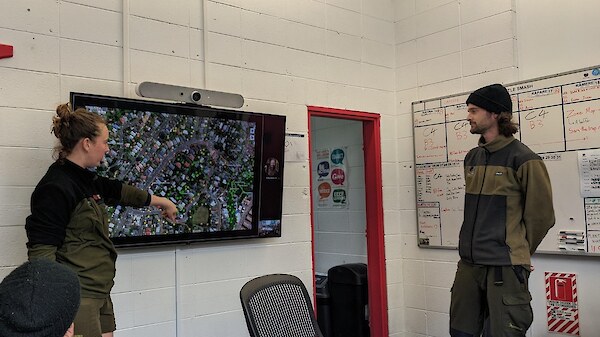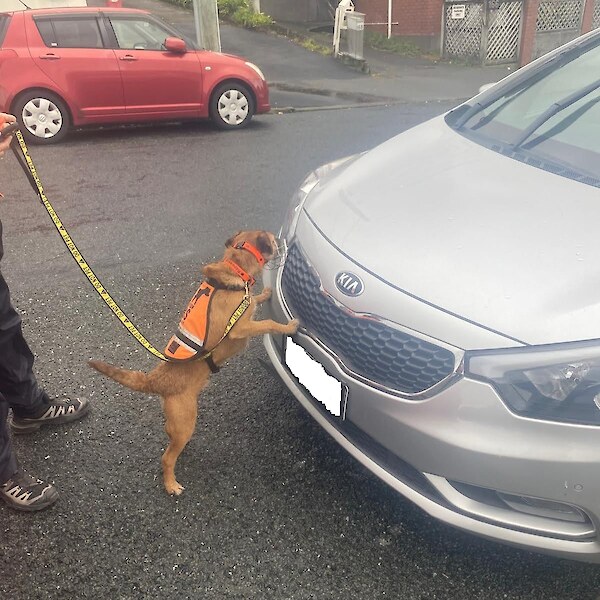How we keep improving
We’re experts in urban rat removal but when we first started, no one had successfully removed rats from an entire suburb or city. We learnt lots from island eradications and also knew that engaging the community was essential. As our project has developed we have kept trying new things to make our work faster and cheaper. Here are some of our recent changes.
You can learn more about our project in our blueprint (which is currently version one).
Leader of the pack
 Reviewing the day in our afternoon debriefWhile we have supervisors and some of the team have been working longer than others, all our field operators are highly trained. That’s why in September we introduced ‘area leads’. Field operators who are leads are like captains of a sports team, specialising in an area and working with the technical team to help plan how the team will work each day. This system builds capability in the team and lets the supervisors plan longer-term work.
Reviewing the day in our afternoon debriefWhile we have supervisors and some of the team have been working longer than others, all our field operators are highly trained. That’s why in September we introduced ‘area leads’. Field operators who are leads are like captains of a sports team, specialising in an area and working with the technical team to help plan how the team will work each day. This system builds capability in the team and lets the supervisors plan longer-term work.
Checking the hotspots
When do you do your best work? Maybe first thing in the morning, or late on Friday afternoon? When we are trying to remove the final rats in a ‘hotspot’, we need to check where they are most likely to be. That means we focus on areas which had activity the last time we were there, check trouble spots first thing in the morning and early in the week. After hours of hard work, the team might miss a crucial detail in the field. Removing every last rat needs our full attention.
Take time to save time
We tell residents when we’ll be installing a trap at their place. Our Community Outreach team has recently increased this notice period from two weeks to four. This gives the team more time to confirm property access and identify any special considerations like dogs or peanut allergies. Having a longer lead-in time means we can ‘reconfirm’ more properties so the field team can be confident that residents are expecting them. This speeds up trap installs which makes the whole project move faster.
Brief morning briefings
Each day at Predator Free Wellington starts with a briefing for the field team. This covers where each of the two or three teams are working that day. Previously we’d all run through each team’s work and issues they needed to watch for. From September we changed to quickly checking the weather forecast before splitting into teams. By having more focused meetings, the team is in the field around half an hour earlier each day. During a short afternoon debrief, we cover how each team went, so everyone is on the same page.
Just the right amount
Our project uses a network of traps every 100m and a bait station every 50m. But what if we’re confident this isn’t needed? We know a lot about rat habitat and dense weeds like cape ivy need a lot of attention. Heavily concreted areas and residential zones don’t need as much. With our recent installs in suburban Mt Victoria and Newtown, our team knows that we can put in ‘the right amount’ of traps. Installing more devices than we need means more to check, which takes longer and stops us moving forward on the project.
Strong smells and smarter data
 Our team includes some pretty powerful noses. Rapu and Kimi are our specialist rat detection dogs. They work with handler Sally to find rats in places people would never think to look and can follow ratty trails into tight spots. While their work is essential, we also need more data before automatically chasing everything they do. When the dogs strongly indicate a rat, it could be an old catch or strong lingering scent. A dry garage can smell ratty for ages. Before we move back into an area we think is rat-free: can we see this rat on camera? Are there chews on a chew card? When we are confident it’s there, then we’ll act.
Our team includes some pretty powerful noses. Rapu and Kimi are our specialist rat detection dogs. They work with handler Sally to find rats in places people would never think to look and can follow ratty trails into tight spots. While their work is essential, we also need more data before automatically chasing everything they do. When the dogs strongly indicate a rat, it could be an old catch or strong lingering scent. A dry garage can smell ratty for ages. Before we move back into an area we think is rat-free: can we see this rat on camera? Are there chews on a chew card? When we are confident it’s there, then we’ll act.
With your help we can keep improving how we work across the city. Learn how you can support us here.
Posted: 14 April 2025
